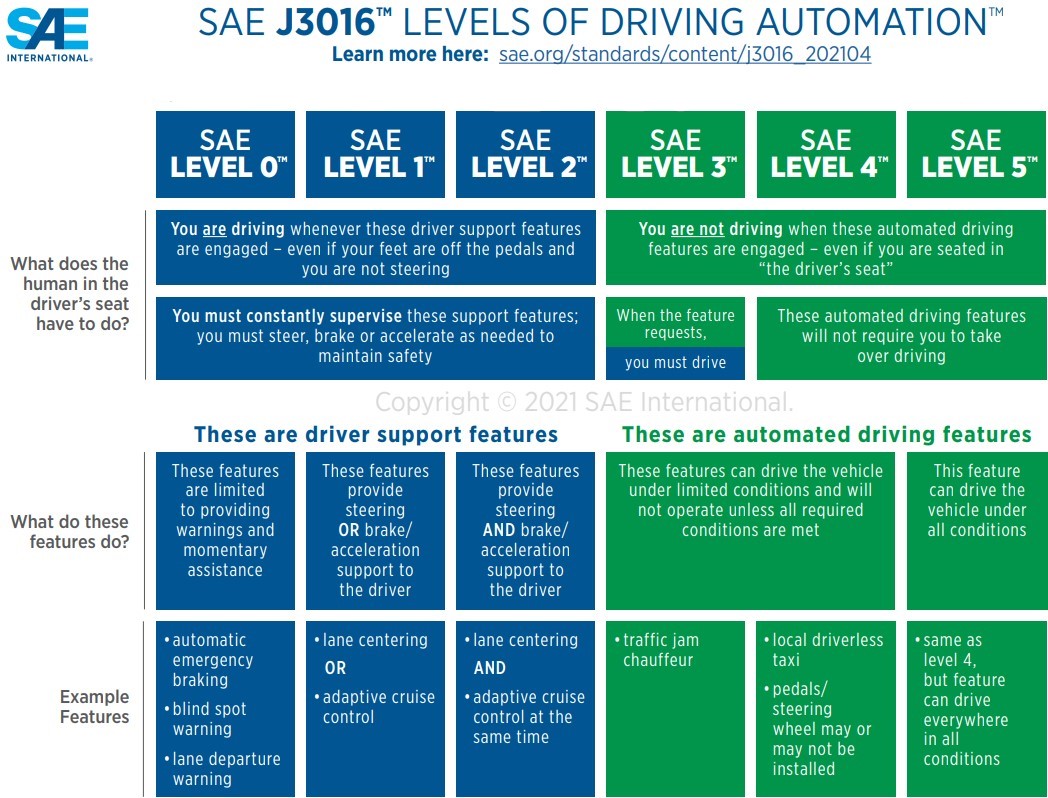Autonomous vehicles (AVs) are a hot topic in today’s news, with the efforts of vehicle and technology companies regularly making headlines. Evidence of these efforts can be seen all around the country. In 2011, Nevada was the first state to authorize the operation of autonomous vehicles, and to date, 38 states have passed legislation or regulations regarding AVs, according to the Governors Highway Safety Association. These authorized activities ranging from studies on AVs to vehicle testing with or without a human operator.
While fully autonomous vehicles already exist and are being extensively tested, the technology that consumers can buy today is only partially autonomous and is intended to assist a fully functioning driver. The Society of Automotive Engineers (SAE) has helpfully developed a system of numbered levels to describe the extent of a vehicle’s driving automation. Despite assurances that AVs are on the horizon, the majority of vehicles on the road today are still at Level 0, meaning they are completely reliant on a human driver.
 Some newer vehicles, however, have begun to include two features that are key components to vehicle automation: adaptive cruise control, which operates the vehicle at a set speed and will brake to maintain a safe following distance, and lane centering, which controls the lateral movement of the vehicle within a lane. A vehicle with either of these features has ascended to the SAE’s Level 1, while Level 2 vehicles can perform both these functions simultaneously.
Some newer vehicles, however, have begun to include two features that are key components to vehicle automation: adaptive cruise control, which operates the vehicle at a set speed and will brake to maintain a safe following distance, and lane centering, which controls the lateral movement of the vehicle within a lane. A vehicle with either of these features has ascended to the SAE’s Level 1, while Level 2 vehicles can perform both these functions simultaneously.
Currently, five Level 2 systems are offered in vehicle models sold in the U.S. by six manufacturers: Acura and Audi (Traffic Jam Assist), BMW (Driving Assistant Plus), Cadillac (SuperCruise), Nissan (ProPilot Assist), and Tesla (Autopilot). It is important to note that even Level 2 is not considered truly autonomous; no vehicle available to the public today can be safely operated without the continuous monitoring and active engagement of an attentive driver.
So, while Level 2 vehicles are touted as almost autonomous, emphasis ought to be placed on the word almost. Each of these systems attempts to maintain driver attention by alerting a driver when either the hands are off the wheel or the eyes are off the road. Level 3, when available, will be the first level considered truly autonomous, as the car will do all the driving unless the system fails or alerts the driver to take over. (Audi earlier said it would release the first Level 3 vehicle to the market this year, but has shelved that plan, reportedly due to too many U.S. regulatory challenges.)
However, several high-profile crashes that have made the news in recent months suggest some drivers are operating Level 2 vehicles as though they are at Level 3 or higher. The Insurance Institute for Highway Safety (IIHS) recently studied a couple of potential reasons that misconception may occur: system names and instrument cluster information.
IIHS suspected—and confirmed—that system names that overpromise the level of automation can lull drivers into false expectations. Notably, compared to the Level 2 systems of other brands, the greater likelihood that a survey participant felt Tesla’s AutoPilot could be used as one would a Level 3 vehicle was statistically significant: nearly half thought AutoPilot was hands-free, and a substantially larger proportion thought it allowed the driver to use a phone or read a book while driving. Astonishingly, 6% thought it would be safe to take a nap while at the wheel.
Another source of driver information is the instrument panel cluster, which displays illuminated signs to indicate how/when specific systems are operating. Dashboard icons have been around for decades, but these signals are more sophisticated and will take on new importance in the age of driverless vehicles; they will provide one way to alert drivers to changing situations, including times when the driver may need to take control of the vehicle. The IIHS found that, among 80 volunteers, many understood the display when adaptive cruise or lane assist was working properly, but had a harder time understanding displays meant to indicate a problem (like the system’s inability to detect lane markings or a vehicle ahead). The half of the group that received some pretraining on the vehicle systems did better, in general, than the group that did not, suggesting that new-owner orientation at a dealership will be extremely important.
Find details of these studies at IIHS in the June 2019 issue of Status Report.
CPSTs and caregivers can learn more about the features of specific vehicle models by using the National Safety Council’s simple guide to safety features, called My Car Does What?
